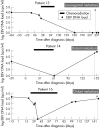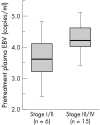Role of Epstein-Barr virus DNA measurement in plasma in the clinical management of nasopharyngeal carcinoma in a low risk area
- PMID: 16489178
- PMCID: PMC1860284
- DOI: 10.1136/jcp.2005.030544
Role of Epstein-Barr virus DNA measurement in plasma in the clinical management of nasopharyngeal carcinoma in a low risk area
Abstract
Objective: To evaluate the role of quantitative measurement of Epstein-Barr virus (EBV) DNA in the clinical management of nasopharyngeal carcinoma (NPC) in a low tumour risk area (western Europe).
Methods: 22 consecutive Dutch NPC patients (11 europid) were studied. EBV DNA load in pretreatment and post-treatment plasma samples was determined. Three patients were also sampled at frequent intervals during treatment. RNA in situ hybridisation for the detection of EBV encoded RNAs (EBERs) was carried out on tumour biopsies of all cases.
Results: All patients with EBER positive NPC (20/22) showed a positive EBV DNA load in plasma at the time of diagnosis (median EBV DNA level, 4.1 log(10) copies/ml). Patients with EBER negative NPC had no detectable EBV DNA in plasma. After treatment, complete remission was achieved in all cases and concurrently EBV DNA in plasma became undetectable in all patients. In the three longitudinally evaluated cases, EBV DNA load gradually declined towards undetectable levels within three weeks after start of treatment. Two patients developed a distant metastasis with concomitant increases in EBV viral load. In addition, one EBER positive patient developed an EBER negative metastasis in the neck during follow up and in this case EBV DNA load remained undetectable at the time of recurrence.
Conclusions: Plasma EBV DNA load measurement appears to be useful in a low tumour risk area. However, development of local recurrences may not always coincide with raised levels of EBV DNA.
Similar articles
-
Pretherapy quantitative measurement of circulating Epstein-Barr virus DNA is predictive of posttherapy distant failure in patients with early-stage nasopharyngeal carcinoma of undifferentiated type.Cancer. 2003 Jul 15;98(2):288-91. doi: 10.1002/cncr.11496. Cancer. 2003. PMID: 12872347
-
Comparison of plasma Epstein-Barr virus (EBV) DNA levels and serum EBV immunoglobulin A/virus capsid antigen antibody titers in patients with nasopharyngeal carcinoma.Cancer. 2004 Mar 15;100(6):1162-70. doi: 10.1002/cncr.20099. Cancer. 2004. PMID: 15022282
-
[Quantitative analysis of Epstein-Barr virus DNA in plasma and peripheral blood cells in patients with nasopharyngeal carcinoma].Zhonghua Yi Xue Za Zhi. 2004 Jun 17;84(12):982-6. Zhonghua Yi Xue Za Zhi. 2004. PMID: 15312530 Chinese.
-
Application of circulating plasma/serum EBV DNA in the clinical management of nasopharyngeal carcinoma.Oral Oncol. 2014 Jun;50(6):527-38. doi: 10.1016/j.oraloncology.2013.12.011. Epub 2014 Jan 15. Oral Oncol. 2014. PMID: 24440146 Review.
-
Serum/plasma viral DNA: mechanisms and diagnostic applications to nasopharyngeal and cervical carcinoma.Ann N Y Acad Sci. 2001 Sep;945:59-67. Ann N Y Acad Sci. 2001. PMID: 11708495 Review.
Cited by
-
Phase I trial of adoptively transferred tumor-infiltrating lymphocyte immunotherapy following concurrent chemoradiotherapy in patients with locoregionally advanced nasopharyngeal carcinoma.Oncoimmunology. 2015 Mar 6;4(2):e976507. doi: 10.4161/23723556.2014.976507. eCollection 2015 Feb. Oncoimmunology. 2015. PMID: 25949875 Free PMC article.
-
Complementary determination of Epstein-Barr virus DNA load and serum markers for nasopharyngeal carcinoma screening and early detection in individuals at risk in Tunisia.Eur Arch Otorhinolaryngol. 2012 Mar;269(3):1005-11. doi: 10.1007/s00405-011-1717-5. Epub 2011 Jul 30. Eur Arch Otorhinolaryngol. 2012. PMID: 21805179
-
Prognostic value of Epstein-Barr virus DNA load in nasopharyngeal carcinoma: a meta-analysis.Pan Afr Med J. 2022 Jan 3;41:6. doi: 10.11604/pamj.2022.41.6.28946. eCollection 2022. Pan Afr Med J. 2022. PMID: 35145598 Free PMC article. Review.
-
Validation of Roche LightCycler Epstein-Barr virus quantification reagents in a clinical laboratory setting.J Mol Diagn. 2006 Nov;8(5):589-97. doi: 10.2353/jmoldx.2006.050152. J Mol Diagn. 2006. PMID: 17065428 Free PMC article.
References
-
- McDermott A L, Dutt S N, Watkinson J C. The aetiology of nasopharyngeal carcinoma. Clin Otolaryngol 20012682–92. - PubMed
-
- Fandi A, Cvitkovic E. Biology and treatment of nasopharyngeal cancer. Curr Opin Oncol 19957255–263. - PubMed
-
- Marks J E, Phillips J L, Menck H R. The National Cancer Database report on the relationship of race and national origin to the histology of nasopharyngeal carcinoma. Cancer 199883582–588. - PubMed
MeSH terms
Substances
LinkOut - more resources
Full Text Sources



